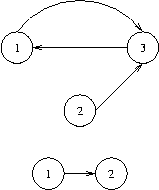poj2553——The Bottom of a Graph(强连通分量)
来源:互联网 发布:男装批发软件 编辑:程序博客网 时间:2024/05/22 10:31
Description
We will use the following (standard) definitions from graph theory. Let V be a nonempty and finite set, its elements being called vertices (or nodes). Let E be a subset of the Cartesian product V×V, its elements being called edges. Then G=(V,E) is called a directed graph.
Let n be a positive integer, and let p=(e1,…,en) be a sequence of length n of edges ei∈E such that ei=(vi,vi+1) for a sequence of vertices (v1,…,vn+1). Then p is called a path from vertex v1 to vertex vn+1 in G and we say that vn+1 is reachable from v1, writing (v1→vn+1).
Here are some new definitions. A node v in a graph G=(V,E) is called a sink, if for every node w in G that is reachable from v, v is also reachable from w. The bottom of a graph is the subset of all nodes that are sinks, i.e., bottom(G)={v∈V|∀w∈V:(v→w)⇒(w→v)}. You have to calculate the bottom of certain graphs.
Input
The input contains several test cases, each of which corresponds to a directed graph G. Each test case starts with an integer number v, denoting the number of vertices of G=(V,E), where the vertices will be identified by the integer numbers in the set V={1,…,v}. You may assume that 1<=v<=5000. That is followed by a non-negative integer e and, thereafter, e pairs of vertex identifiers v1,w1,…,ve,we with the meaning that (vi,wi)∈E. There are no edges other than specified by these pairs. The last test case is followed by a zero.
Output
For each test case output the bottom of the specified graph on a single line. To this end, print the numbers of all nodes that are sinks in sorted order separated by a single space character. If the bottom is empty, print an empty line.
Sample Input 
3 3
1 3 2 3 3 1
2 1
1 2
0
Sample Output
1 3
2
昨天错了一晚上,今天换个模板就过了。。。
题意是求所有的sink node,即互相有连接的点。图中第一个样例里,1、3互相连接,但2、3没有,所以答案是1和3,。所以根据定义就知道是要求强连通分量里出度为0的点,然后把这些点按顺序输出
#include <iostream>#include <algorithm>#include <cstdio>#include <cstring>#define MAXN 5005using namespace std;struct Node{ int x,y,next;} edge[MAXN*MAXN];int dfn[MAXN],low[MAXN],vis[MAXN],s[MAXN],belong[MAXN],head[MAXN];int in[MAXN],out[MAXN]; //入度,出度int n,tot=0,ssum=0,ans=0,times=0,t=0,ans2;void init(){ memset(head,-1,sizeof(head)); memset(dfn,0,sizeof(dfn)); memset(vis,0,sizeof(vis)); memset(low,0,sizeof(low)); memset(belong,0,sizeof(belong)); memset(out,0,sizeof(out)); tot=ssum=0;}void add(int x,int y){ edge[++tot].x=x; edge[tot].y=y; edge[tot].next=head[x]; head[x]=tot;}void tarjan(int x){ int y,i; times++; t++; dfn[x]=low[x]=times; vis[x]=1; s[t]=x; for (i=head[x]; i; i=edge[i].next) { y=edge[i].y; if (vis[y]==0) { tarjan(y); low[x]=min(low[x],low[y]); } if (vis[y]==1) low[x]=min(low[x],dfn[y]); } if (dfn[x]==low[x]) { ssum++; do { y=s[t--]; belong[y]=ssum; vis[y]=2; } while (y!=x); }}int main(){ int i,j; while(cin >> n&&n) { init(); int v,u; scanf("%d",&j); while(j--) { scanf("%d%d",&u,&v); add(u,v); } for (i=1; i<=n; i++) if (vis[i]==0) tarjan(i); for (i=1; i<=tot; i++) if (belong[edge[i].x]!=belong[edge[i].y]) { out[belong[edge[i].x]]++; } for(i=1;i<=n;++i) if(out[belong[i]]==0) cout<<i<<" "; cout<<endl; }}- poj2553-The Bottom of a Graph(强连通分量)
- poj2553——The Bottom of a Graph(强连通分量)
- poj2553 The Bottom of a Graph--Kosaraju算法 & 缩点 & 强连通分量
- POJ2553 The Bottom of a Graph 强连通 tarjan
- The Bottom of a Graph-POJ2553强连通
- poj2553 The Bottom of a Graph【强连通】
- POJ 2553——The Bottom of a Graph(强连通分量)
- 强连通分量 ( Tarjan,邻接链表 )——The Bottom of a Graph ( POJ 2553 )
- poj 2553 The Bottom of a Graph(强连通分量)
- The Bottom of a Graph 强连通分量加缩点
- POJ 2553 The Bottom of a Graph 强连通分量
- POJ 2553 The Bottom of a Graph(强连通分量)
- POJ 2553 The Bottom of a Graph (强连通分量)
- POJ 2553 The Bottom of a Graph(强连通分量)
- POJ 2553 The Bottom of a Graph 强连通分量
- poj 2553 The Bottom of a Graph【强连通分量】
- poj2553——The Bottom of a Graph
- POJ2553——The Bottom of a Graph
- 一个网站重要的在于细节,我们要学会耐心的去完善,去更改
- 面向项目(六)—— 错误(异常)信息的书写
- Courses(二分图水题)
- 网络HTTP、TCP、UDP、Socket 知识总结
- 《关于SDL中的色彩键控》
- poj2553——The Bottom of a Graph(强连通分量)
- HDU1106 排序
- 《java入门第一季》之面向对象(包概述)
- 并查集初学(1)
- 那一年, 我第一次听说华为
- java后台数据库同步使用map进行缓存
- android中bitmap用法示例
- Git使用后的一些思考
- VB 控制台输出"HelloWorld!"


